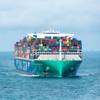Great Lakes Shipping Industry Urges Fast WRRDA Approval
The Great Lakes shipping industry is calling on Congress to quickly pass the Water Resources Reform and Development Act (WRRDA) approved by the House/Senate conference committee. The bill contains provisions that will significantly reduce the dredging backlog on the Great Lakes by increasing the amount of tax dollars the government spends on maintaining deep-draft ports and waterways and designating the Great Lakes a “navigation system” for the purposes of maintenance dredging.
“It is critical that Congress move this bill now,” said James H.I Weakley, President of Great Lakes Maritime Task Force (GLMTF), the largest labor/management coalition ever to represent shipping on the Lakes. “More than 18 million cubic yards of sediment clog the Great Lakes Navigation System. Vessels have not been able to carry full loads since 1997, and that was only because water levels were at near record highs that year.
“The Harbor Maintenance Trust Fund (HMTF) has a surplus of more than $8 billion. This WRRDA will require the government to steadily increase national harbor maintenance funding, reaching 100 percent of HMTF revenues by 2025.
“The bill also directs the Corps to recognize the interdependence of Great Lakes ports, large and small, and to manage them as a single, comprehensive system, with the focus more on regional economic impacts and less on annual tonnage measurements.
“The WRRDA also formally defines the Great Lakes Navigation System so that Federal funding can be appropriated only for use within that system.”
Weakley, who is also President of Lake Carriers’ Association, stressed that the need for dredging has taken on a new urgency following the brutal winter of 2013/2014. “Only a fraction of the cargo that needed to move in March and April was shipped because the ice was so thick. We need to cram every ton we can into the cargo holds if we are to stand any chance of rebuilding stockpiles at steel mills and power plants to necessary levels. The Corps must do everything in its power to restore the Great Lakes Navigation System as quickly as possible.”
John D. Baker, 1st Vice President of GLMTF, emphasized that dredging will always be an annual need. “The natural rate of siltation into the Lakes is more than 3 million cubic yards per year. Under the current the scheme of things, most years the Corps doesn’t get enough money to keep pace with the normal influx of sediment, let alone reduce the backlog. That’s why it is so important that this WRRDA pass and America finally has a dredging program that properly maintains the Lakes and connecting waterways.”
Baker, who is also President Emeritus of the ILA’s Great Lakes District Council, noted that ocean-going vessels trading to the Lakes via the St. Lawrence Seaway have also been losing cargo to the dredging crisis. “Our coastal ports are congested, whereas the Lakes, if dredged to project depth, would have capacity to spare. There’s no need for cargos that originate in or are destined for the Great Lakes basin to be railed and trucked to and from coastal port ranges. They should be landed and loaded here. Not only will that be more efficient, it will be better for the environment. Waterborne commerce is the greenest form of transportation.”
About GLMTF
Founded in 1992, Great Lakes Maritime Task Force promotes domestic and international shipping on the Great Lakes. With 85 members, it is the largest coalition to ever speak for the Great Lakes shipping community and draws its membership from both labor and management representing U.S.-flag vessel operators, shipboard and longshore unions, port authorities, cargo shippers, terminal operators, shipyards and other Great Lakes interests.













